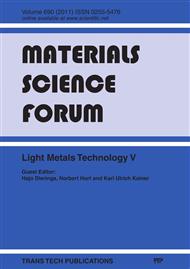p.262
p.266
p.270
p.274
p.278
p.282
p.286
p.290
p.294
Modeling Bolt Load Retention of Ca Modified AS41 Using Compliance-Creep Method
Abstract:
Adequate quantification of the degree of fastener clamp load retained at bolted joint of Mg-Al alloys is crucial to develop new elevated temperature resistant Mg-alloys. Several attempts have been made in the past to model Bolt Load Retention (BLR) behaviour of Mg-alloys using different approaches. It must be mentioned that whereas these models attempt to predict BLR of the alloys investigated, the results of the models differ in most cases with the experiments by great margin. The BLR behaviour of Mg-alloy is geometry and material dependent. This means that, the configuration of the test sample, the compliance of the bolt/joint and creep response of the material under investigation play important role in determining the joint response under load and temperature. In this work, BLR and creep behaviour of Ca modified AS41 is investigated and compared to that of Mg4Al and AS41. A compliance-creep approach is used to model the response of these Mg-Al alloys at bolted joints. The model prediction of the BLR response and experimental results as obtained in this work are in good agreement. AS41+0.15 % Ca shows improved creep and BLR properties up to 175 °C. A correlation between the microstructures, creep and BLR results reveal that the formation of a ternary CaMgSi phase is responsible for the improved elevated temperature behaviour.
Info:
Periodical:
Pages:
278-281
Citation:
Online since:
June 2011
Keywords:
Price:
Сopyright:
© 2011 Trans Tech Publications Ltd. All Rights Reserved
Share:
Citation:


